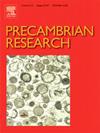New geochronological evidences and diverse arc-related meta-volcanic rock suits from the Northern Liaoning terrane, North China Craton
IF 3.2
2区 地球科学
Q2 GEOSCIENCES, MULTIDISCIPLINARY
引用次数: 0
Abstract
The Northern Liaoning terrane locates at the northeastern margin of the North China Craton (NCC). Two debatable tectonic mechanisms, plate tectonic vs. plume/sagduction, were interpreted to dominate the late Neoarchean Northern Liaoning terrane. Besides, ∼2.57–2.51 Ga supracrustal rocks occur layered or as enclaves within ∼ 2.59–2.50 Ga TTG and potassium-rich granitoid gneisses. This is a logical contradiction that ‘young’ enclaves expose within ‘older’ wall rocks. In this study, new zircon U-Pb dating results exhibit that protoliths for these meta-volcanic rocks in the Huiyuan area, north of the Northern Liaoning terrane, crystallized at ∼ 2.61 Ga and underwent metamorphisms at ∼ 2.54–2.48 Ga. The real crystallization ages for reported metavolcanic rocks in the Northern Liaoning terrane were probably highly underestimated.
In this contribution, garnet–pyroxene amphibolite, amphibolite and (biotite) amphibole gneiss were interbedded and exhibit geochemical affinities to Nb-enriched basalt (NEB), tholeiite and andesite, respectively. NEB exhibits abnormally high Nb, TiO2 and (Nb/La)PM values, fractionated REE patterns, and negligible Nb, Ta and Ti anomalies, which was derived from partial melting of slab melts metasomatized mantle wedge with Nb-bearing minerals (i.e., amphibole). Tholeiites yield flat REE patterns, enrichments of LILEs, and depletions of Nb and Zr, which are comparable to primitive arc basalt and interpreted as partial melting of sub-arc mantle wedge previously metasomatized by limited subducted slab-derived fluids. Andesites give fractionated REE patterns and negative HFSE anomalies, among which several andesites are akin to Phanerozoic high-magnesium andesite (HMA), with high MgO, Mg#, Cr and Ni values, and were generated by interactions between subducted slab-derived melts and sub-arc mantle wedge. Remained normal andesites were hybrids of crustal melts and mantle-derived basaltic melts. Taken together, ∼2.61 Ga NEB, andesite (including HMA samples) and primitive arc basalt associations point to a subduction tectonic mechanism developing in the Northern Liaoning terrane. Plume and subduction mechanisms are not mutually exclusive. More precise spatial and temporal distributions effected by plume and subduction, respectively, and how they interact with each other, need to be further studied.

华北克拉通辽北地体地质年代学新证据及不同弧相关变质火山岩套装
辽北地体位于华北克拉通东北缘。两种有争议的构造机制——板块构造和地幔柱/凹陷作用——被解释为主导新太古代晚期辽北地体的构造机制。此外,在~ 2.59-2.50 Ga的TTG和富钾花岗质片麻岩中,~ 2.57-2.51 Ga的上地壳岩石呈层状或包裹状。这是一个逻辑矛盾,“年轻”的飞地暴露在“老”的围岩中。新的锆石U-Pb定年结果表明,辽北地体北部汇源地区这些变质火山岩的原岩在~ 2.61 Ga结晶,并在~ 2.54 ~ 2.48 Ga变质。辽北地区已报道的变质火山岩的实际结晶年龄可能被严重低估。其中石榴辉石角闪岩、角闪岩和(黑云母)角闪片麻岩互层,分别与富铌玄武岩(NEB)、拉斑岩和安山岩具有地球化学亲缘关系。NEB表现出异常高的Nb、TiO2和(Nb/La)PM值,REE分馏模式,Nb、Ta和Ti异常可忽略不计,这是由于板熔体交代地幔楔与含铌矿物(即角闪孔)部分熔融所致。拉斑岩REE模式平坦,LILEs富集,Nb和Zr耗尽,与原始弧玄武岩相当,解释为亚弧地幔楔的部分熔融,之前由有限的俯冲板源流体交代。安山岩REE分异,HFSE负异常,其中部分安山岩类似显生宙高镁安山岩(HMA),具有较高的MgO、Mg#、Cr和Ni值,由俯冲板源熔体与弧下地幔楔相互作用产生。剩下的正常安山岩是地壳熔体和幔源玄武岩熔体的混合体。综合来看,~ 2.61 Ga NEB、安山岩(包括HMA样品)和原始弧玄武岩组合表明,辽北地体发育俯冲构造机制。地幔柱和俯冲机制并非相互排斥。更精确的时空分布分别受到羽流和俯冲的影响,以及它们如何相互作用,需要进一步研究。
本文章由计算机程序翻译,如有差异,请以英文原文为准。
求助全文
约1分钟内获得全文
求助全文
来源期刊

Precambrian Research
地学-地球科学综合
CiteScore
7.20
自引率
28.90%
发文量
325
审稿时长
12 months
期刊介绍:
Precambrian Research publishes studies on all aspects of the early stages of the composition, structure and evolution of the Earth and its planetary neighbours. With a focus on process-oriented and comparative studies, it covers, but is not restricted to, subjects such as:
(1) Chemical, biological, biochemical and cosmochemical evolution; the origin of life; the evolution of the oceans and atmosphere; the early fossil record; palaeobiology;
(2) Geochronology and isotope and elemental geochemistry;
(3) Precambrian mineral deposits;
(4) Geophysical aspects of the early Earth and Precambrian terrains;
(5) Nature, formation and evolution of the Precambrian lithosphere and mantle including magmatic, depositional, metamorphic and tectonic processes.
In addition, the editors particularly welcome integrated process-oriented studies that involve a combination of the above fields and comparative studies that demonstrate the effect of Precambrian evolution on Phanerozoic earth system processes.
Regional and localised studies of Precambrian phenomena are considered appropriate only when the detail and quality allow illustration of a wider process, or when significant gaps in basic knowledge of a particular area can be filled.
 求助内容:
求助内容: 应助结果提醒方式:
应助结果提醒方式:


